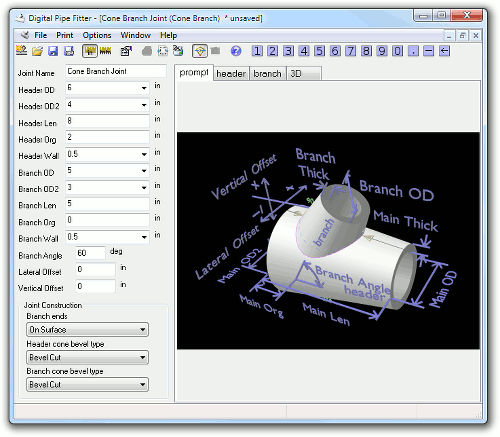The Cone Branch Joint is the intersection of the end of one cone shaped component, with the side of another cone shaped component.
This joint is similar to the standard branch joint except it works with conical shapes.
Where a pipe in a branch joint has assumed infinite length and a single constant diameter, a cone component has a fixed length and usually different diameters on each end. Cone components also need to be positioned along their axis, so a parameter Org (for Origin) is also specified. Org is the distance from the first end opening to the intersection point of the joint. So, for example if a header cone has a length of 10 inches and an Org of 5 inches, then the branch component will intersect the header's axis half way along the header's length.
Two templates are created. One for the end of the branch component and another for the side hole or holes in the header component. If the orientation is such that the two components are touching end to end, both components will have end cuts.
The templates will contain cutlines that assume the components extend past their specified length. This is done for several practical reasons and for consistancy. As a result, unexpected cutlines my be generated that the user might choose to ignore. Be sure to view the joint in the 3D preview to confirm that it is what you expect.
For the template generation to be successful, the specified joint must result in one or more holes in the header component and a cut off end of the branch component. There is not a cone equivalent of the pipe intereference joint. However, if part of the branch joint passes along side the header component, the cutline will be created so that the full specified length of the branch component is used. This again, can result in some odd cutlines so be sure you understand the cutline before using it.
At small and large branch angles, the cutline on the header component may wrap all the way around the end of the header. Joint Construction definitions are maintained. If you want an end to end joint with the bevels of the two components touching, use the same parameters on a cone miter joint.
Parameter Constraints:
Joint Name: name of this joint which is unique to this project or currently opened joints
Header OD: outside diameter of first end of the header component (must be a positive number)
Header OD2: outside diameter of second end of the header component (must be a positive number)
Header Len: length of the header component (must be a positive number)
Header Org: the distance from the first end (OD) of the header component where the intersection with the branch will be if Vertical Offset and Lateral Offset are zero (This parameter positions the header component along its axis relative to the branch component.)
Header Wall: must be a positive number, less than half of the smallest header diameter (OD or OD2)
Branch OD: outside diameter of first end of the branch component (must be a positive number)
Branch OD2: outside diameter of second end of the branch component (must be a positive number)
Branch Len: The length of the branch component. (must be a positive number)
Branch Org: the distance from the first end (OD) of the branch component where the intersection with the header centerline will be if Vertical Offset and Lateral Offset are zero (This parameter positions the branch component along its axis relative to the header component.)
Branch Wall: must be a positive number, less than half of the smallest branch diameter (OD or OD2)
Branch Angle: more than 0 deg. and less than 180 deg. (90 deg. is a perpendicular joint.)
Lateral Offset: a positive or negative distance that the branch is moved sideways relative to the header component
Vertical Offset: a positive or negative distance that the branch is moved up and down relative to the header component's axis
Joint Construction Notes:
The details of Joint Constructions are handled consitantly with the standard Branch Joint. But, the Cone Branch Joint is a very complex joint with many possible orientations and possibilities to get confused. For example, if a Joint Construction is selected that would normally create two holes in the header, it is possible that the Cone Branch Joint will only intersect the header on one side resulting in one hole.
For an "On Inside Wall" or "On Far Outside Wall" construction, the header template is sized to fit snug around the cut end of the branch component. There will never be a gap between the branch componentand header component as long as the two component are long enough to complete the joint and thier orientation allows the joint to exist. The best example of this optimization is when both components bevel type is set to 'Perpendicular Cut'.
Whenever possible, even if no cutline is generated, a 3D preview will be available to help orient the two components. The 3D preview simplifies the task of entering parameters into this complexity joint type since the orientation of the two components can usually be seen. If the branch component is not visible in the 3D preview, then likely it is completely below the specified header intersect surface. In order to see where the branch component is, try temporarily changing the joint constrution, branch ends setting to "All the Way Through". Then the branch should become visible.

